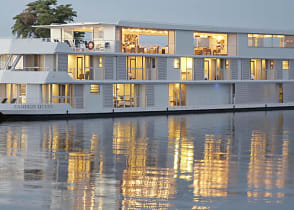4 Ways to Get Around on an African Safari

Safari vehicle at sunset in South Africa
A safari in Africa is a collection of moments. It could be the pre-dawn stillness, holding a warm cup of coffee as the first hint of silver light spills over the horizon, or the hushed anticipation in the safari vehicle as the tracker deciphers the story left in the dust overnight. As vital as sighting the wildlife are the ways to get around on an African safari.
The way you traverse the vast landscapes, whether by land, air, rail, or water, fundamentally shapes your perspective and connection to the continent. From thrilling game drives to luxurious train journeys, discover how the transit can become a highlight of your adventure on this incredible continent.
Extraordinary travel begins with a human touch, and our destination specialists design every journey with care, insight, and personal attention. As you consider a visit to Africa for a safari, let the following information guide you before connecting with our travel experts to help you plan your trip.
Essential Safari Travel Information

Woman experiencing a safari in South Africa.
Answering these practical questions is the first step in crafting a flawless safari. Understanding the logistics of vehicles, flights, and local customs ensures your journey is as comfortable and stress-free as it is thrilling.
- Vehicle Types: The vehicle you travel in significantly impacts your experience. Open-sided 4x4s, common in Southern Africa, offer unparalleled, immersive photographic opportunities. Closed 4x4s with pop-top roofs, common in East Africa, provide more protection from the elements. The ultimate luxury is a private vehicle and guide, which offers complete flexibility to linger at a sighting, focus on specific interests like birding, and set your own pace, a crucial benefit for families or photographers.
- Fly-In Safari Luggage Rule: This is a critical, non-negotiable rule for safety on light aircraft transfers. Travelers are restricted to one soft-sided duffel bag with no wheels or rigid frames. The maximum weight is typically 44 pounds, including all hand luggage and camera equipment. The usual maximum dimensions are 24 to 25 inches long, 12 to 15 inches wide, and 10 to 12 inches high. This is for aircraft balance and safety and is strictly enforced.
- Tipping Your Guides and Drivers: To address this common point of uncertainty, we recommend $30 to $50 per person, per day. This can then be distributed among your guides, trackers, and the general camp staff according to the guidance provided at each lodge.
1. Travel by Car

Game drive in Eastern Serengeti, Tanzania
A classic road safari immerses you directly in Africa's ever-changing landscape. Traveling by private 4x4 offers an exceptional sense of freedom and connection to the ground beneath you. It is important to distinguish between a comfortable transfer vehicle used for road journeys and a specialized game drive vehicle used for wildlife viewing. For travelers with physical concerns, such as back issues, a private vehicle provides a more comfortable and customized experience, ensuring every part of your journey is enjoyable.
- Private vehicles offer flexibility and comfort, with features like charging points and padded roll bars for a superior experience.
- Cultural stops provide the freedom to pause at local villages and scenic viewpoints along your route.
- Changing landscapes allow you to witness the gradual transformation of savannas, forests, and plains.
- Ground-level viewing delivers intimate, eye-level wildlife encounters from your dedicated safari vehicle.
- Worry-free connections create a seamless and personalized journey between lodges, camps, and national parks.
2. Travel by Air

Plane landing in Botswana
To maximize your time and access Africa’s most remote and exclusive wilderness areas, traveling by air is the ultimate convenience. Light-aircraft lodge hops connect disparate ecosystems with exceptional efficiency, turning long journeys into short, scenic flights. The thrill of taking off from and landing on remote bush airstrips, often with wildlife visible right from the plane, is an experience in itself. All cross-border logistics, from flights to visa guidance, are meticulously coordinated by our travel specialists for a stress-free experience.
- Time maximized reduces travel time significantly, allowing for more time to be spent on safari activities.
- Remote access reaches exclusive, secluded camps and lodges that are otherwise inaccessible by road.
- Effortless connections seamlessly link different countries or distant national parks within a single itinerary.
- Aerial perspective offers breathtaking views of migrating herds, vast waterways, and dramatic landscapes.
- Private charters can be arranged for ultimate flexibility and convenience, tailoring the schedule entirely to your needs.
3. Travel by Rail

Rovos Rail traveling on the Namibia Safari route. Photo courtesy of Rovos Rail
Evoking the golden age of exploration, a rail journey on an iconic luxury train like Rovos Rail or the Blue Train adds a layer of timeless romance to your safari. Settle into luxurious carriages and watch the continent’s dramatic landscapes unfold on classic routes like Pretoria to Cape Town or Pretoria to Victoria Falls. This mode of travel transforms the journey into a destination itself, seamlessly integrating safari stops in legendary parks like Kruger or Hwange.
- Elegant travel blends classic luxury and exceptional service with the timeless romance of train journeys.
- Iconic routes connect major cities like Pretoria with natural wonders such as Victoria Falls.
- Seamless safaris provide effortless road transfers to legendary parks like Hwange, Chobe, and Kruger.
- Unfolding vistas showcase a cinematic progression of diverse and dramatic landscapes from your window.
- Epic journeys enable grand, cross-continental adventures connecting the wonders of Southern and Eastern Africa.
4. Travel by Boat

The Zambezi Queen
Traveling by water offers a serene and wonderfully unique perspective on Africa’s wildlife. The experience can vary greatly, from a silent mokoro excursion in the Okavango Delta, bringing you eye-level with the reeds and waterlilies, to a motorboat safari on a larger waterway like the Chobe River, perfect for viewing herds of elephants. For extended journeys, multi-day river cruises on vessels like the Chobe Queen offer another luxurious way to experience a water-based safari.
- Delta exploration navigates the pristine, game-rich waterways of unique ecosystems like the Okavango Delta.
- Silent approach allows for quiet, eye-level wildlife viewing from a traditional canoe.
- River transfers offer a scenic and relaxing way to cross borders or travel between riverside destinations.
- Cultural views provide a unique perspective on the daily lives of communities along the riverbanks.
- Coastal cruising links vibrant port cities like Cape Town and Durban to the starting points of your safari. Cruise-based packages can integrate riverboat or estuary excursions with land-based game drives.
Choosing the Best Way to Travel For Your Safari

A private plane descending onto an airstrip, a classic entry point for a safari adventure.
Your travel style influences the kind of safari you’ll experience. By combining different modes of transport, you can craft a journey perfectly suited to your interests and passions.
- For Families: The flexibility of a private 4x4 vehicle is invaluable. It allows for shorter game drives tailored to children's attention spans and the ability to pack extra snacks and supplies. In malaria-free destinations in parts of South Africa, road transfers are a fantastic and engaging way to see the country together.
- For Honeymooners: The romance and efficiency of fly-in safaris that connect remote, intimate camps are unparalleled. This can be perfectly complemented by the timeless elegance of a luxury train journey, creating a sophisticated and unforgettable adventure for two.
- For Photographers: A private, open-sided 4x4 is essential for the freedom to maneuver for the perfect shot and the space for your equipment. Fly-in safaris also offer unique opportunities for capturing epic aerial photographs of landscapes like the Okavango Delta or the Great Migration.
- For First-Time Safari-Goers: We often recommend a combination approach to get a taste of different travel styles. A typical itinerary might begin with a comfortable road transfer from a city to a nearby park, followed by a scenic light-aircraft flight to a more remote safari destination, offering the best of both worlds.
Find the Best Way to Travel on Your Safari

Herd of elephants crossing the road in Amboseli National Park in Kenya
Discover Africa’s incredible and diverse safari circuit by connecting from one destination to another by land or air, train or boat. The African continent boasts well-established roads and runways, frequent flights, and a range of luxury vehicles. No matter how you get around, the means of transportation are part of the journey.
Learn more in our Africa safari guide and explore our sample African safaris for more inspiration. Whatever your dreams, your Zicasso safari specialist is a destination expert and ready to answer your questions to help you plan your perfect safari.
Life-Enriching Travel Designed Just for You
- 1
Trips curated by the world’s top destination experts
- 2
Concierge-level service leading up to and during your trip
- 3
Unique, exclusive experiences and insider access

